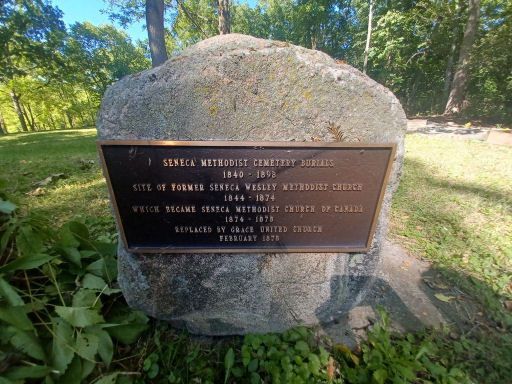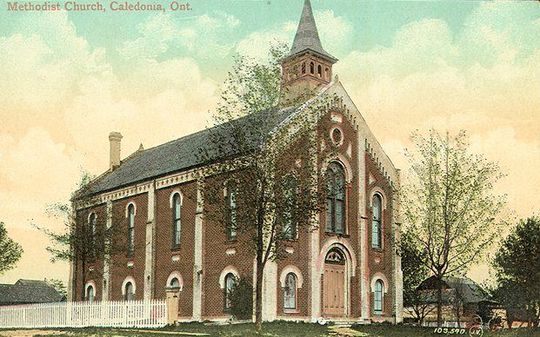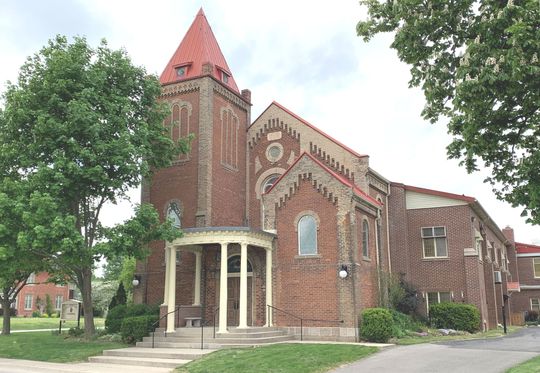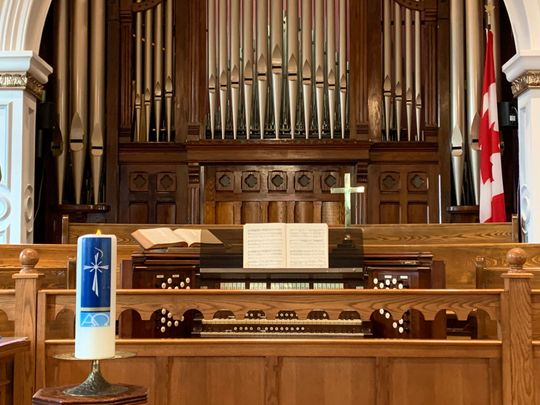About Us
GRACE HISTORY
The cornerstone for the brick Methodist Church at the centre of the building now known as Grace United Church was laid on the 25th of September, 1877, but the congregation has roots back to at least 1838 when Wesleyan Methodists were meeting in what was then known as Seneca Village (on the north bank of the Grand River at the east side of the Caledonia we know today). They built and opened a frame chapel of their own in 1844 on King William St. at Tuscarora St. (where only their cemetery remains) although the interior is said to have not been fully finished until funds were raised in 1851.

Meanwhile, a Methodist New Connexion congregation was also active in the developing village of Caledonia by early 1845, eventually erecting a brick Gothic church at McKenzie Rd. & Haddington Streets. However, following the union of the Wesleyan Methodist Church and the Methodist New Connexion Church in 1874, the joined congregations met in the Seneca building before deciding to build a new, more central church on Caithness St. East at Banff St.
When the new building officially opened Sunday, February 3, 1878, Caledonia was part of a circuit that included the Methodist communities at Unity, York, Fisher's, Seneca West, Zion, and Indiana, meaning the minister only preached in Caledonia once a month, with local "class leaders" responsible for Bible study and prayer meetings.
In 1884, a union of the Bible Christian Church, the Methodist Episcopal Church in Canada, the Methodist Church of Canada and the Primitive Methodists, created what was known as the Methodist Church of Canada for the rest of its existence. In 1922, the Caledonia congregation voted to identify themselves as "Grace Methodist Church." Then in 1925, the Methodist Church of Canada joined most of the Presbyterian Church of Canada and the Congregational Church Union of Canada to form the United Church of Canada. This created the larger and stronger congregation of Grace United Church, despite about a third of the Presbyterians in Caledonia electing to continue in their own church on Argyle St. North.

As the community grew in numbers, the facilities of the existing building showed a need to be both expanded and improved. The congregation experimented with electric and acetylene gas lighting systems while the original building footprint stood otherwise untouched until 1905, when an addition was made to the north end. The tower and two matching stairways were added on the south end in 1909. The original memorial tower carillon was installed in 1943 -- when celebrations were held to mark 100 years since construction began on the original frame chapel in Seneca.
In 1948, Unity United Church, which had continued to share a minister with Grace as a two-point pastoral charge dating back to 1877, ceased holding weekly services. Many remaining members began attending at Grace. In order to accommodate the expanding congregation in the growing town, an addition was erected adjacent to the eastern side of the original brick building and dedicated to the Glory of God on March 20, 1955. The new addition/new wing housed an enlarged sanctuary and Sunday School rooms, a parlour, minister's vestry and a modern kitchen with a furnace room containing two (then) modern oil furnaces,. Thanks to the addition, the seating capacity of the sanctuary was increased by 50%. On October 23, 1960 a new Christian Education Wing on the north end of the building was opened and dedicated, including more classrooms and a large Fellowship Hall. In 1984, a vertical lift (elevator) was installed and in 1990 an infrared system for the hearing impaired added. An accessible automatic door was installed at the Banff entrance in 2015.
Thanks be to God that we as a church family are blessed continually, with a wide cross-section of volunteers who contribute abundantly to the life and to the work of our church, Grace United Caledonia.

OUR ORGAN HISTORY
When you enter the church sanctuary, one of the first things you will notice is our pipe organ. She, a lady of music, is beautifully designed, both inside and out. Throughout the years, so that Lady Pipe Organ could keep up with the times, avoid deterioration and speak through her pipes, the talents, prayers and gifts of many, have been called upon and gratefully appreciated.
Our present pipe organ was not the first to encourage the Grace family to sing praises to the Lord. In 1878, a pipe organ, built by William Greenwood of Rockwood and paid for by the young people, sat in the sanctuary. She was powered by a lad who was paid ten cents a week to pump air into her bellows. Her tone was rich and melodious, far superior to the common reed organ.
However, as grand as she was, in 1896, negotiations began with the firm of Edward Lye and Sons to either improve or replace her. She was replaced in 1897. Total cost --$550.oo plus Lady Pipe Organ 1878.
Unfortunately by 1909, this new instrument was considered inadequate. The firm of Edward Lye & Sons was again contacted, this time to discuss rebuilding. The firm detailed the work entailed in using stops from the 1897 beauty and offered plans for rebuilding and enlarging. The proposal was approved and work began. Mr. George D. Atkinson supervised from his base in Toronto. On Monday evening, November 22, 1909, a ‘Service of Praise’ was held to celebrate the extensive rebuilding. Mr. Atkinson, who was also the organist and choirmaster at St. Paul’s Methodist Church in Toronto, played nine selections in order to demonstrate the wealth within the almost 900 speaking pipes and eighteen stops.
In 1910, a music case and steps for the pumper were constructed. The pumper was now receiving forty dollars per annum. In 1913, the Board of Trustees purchased a motor and blower, thus making it possible for the organ bellows to be filled by a blower powered by an electric motor. Unfortunately, keeping up with the times, meant that the church lads said good-bye to their paying job.
Early in 1949, it was noted that the mechanical (tracker) action of the organ was seriously deteriorating. The Lye Organ Company of Scarborough was able to rebuild. This entailed the installation of electro-pneumatic action throughout, some re-working of the chests, and alterations in the chamber. A new console was installed, with choir seating curving around it. For the first time, an organist could simultaneously play musical selections and direct the choir. The rebuilt organ, with beautiful pipes, two manuals and eighteen stops, was a fine lady.
In 1986, the console was replaced with a used three-manual Casavant console and a Positif division of three ranks was added. This happened thanks to two benefactors--- Mr. and Mrs. Murray Clark and family, in memory of their daughter and sister, Joy Clark MacDonald and the church choir. A dedication service was held on Sunday, September 28th.
The Postif division added to the tonal resources of the pipe organ, made available additional tonal colours and enhanced the brightness of the instrument’s sound. In 1988, two additional ranks of pipes, the Geigen Principal and Clarinet, were purchased.
In 1996, the church sanctuary was renovated. In June of that same year, before work got underway, R.A. Denton & Son of Hamilton, pipe organ builders, were contacted regarding ways to protect the organ, and asked if they would inspect the golden pipes and offer thoughts concerning rebuilding the Casavant console. The organ builders felt that for several reasons, it wasn’t economically feasible or desirable to rebuild the console’s interior components. Rather than use the term ‘a rebuilding of the existing console’, R.A. Denton & Son stated in a proposal dated June 6/03--- “A more accurate description of what needs to be done is to build a new modern and enlarged 3-manual, drawknob console and fit it within the existing oak shell.” Thanks once again to the generosity of the Clark family, we have a magnificent console which was dedicated in honour of Erma Clark Mones on Sunday October 1, 2006.
The Grace United Church family of today, thanks all from the past who took good care of our lady of music, who overcame obstacles in the process and who asked God’ for His help when the challenges seemed enormous.

